Categories
Subjects
Authors
Artists
Venues
Locations
Calendar
Filter
Done
June 24, 2024 – Review
Jordan Strafer’s “DECADENCE”
Stephanie Bailey

“The Kennedys. Palm Beach. A charge of rape. It all made for a real-life soap opera in May 1991 that resulted in an arrest, a trial, and non-stop cable TV coverage.” So reads a recent Miami Herald summary of William Kennedy Smith’s trial, when John F. Kennedy’s nephew was acquitted of raping a twenty-nine-year-old woman. New York-based artist Jordan Strafer fictionalizes that case in “DECADENCE,” an exhibition at the Renaissance Society showing two films back-to-back on a large standing screen, starting with LOOPHOLE (2023). Clocking in at twenty-four minutes (the standard runtime of a TV episode), and filmed in the style of a 1980s soap crossed with a true crime reconstruction, LOOPHOLE draws on sociolinguist Gregory Matoesian’s observations on the “matrix of language, law, and society” that he saw mobilized in Smith’s court proceedings “to create and recreate cultural hegemony”—which Matoesian found to be inextricable with patriarchy. Echoing Matoesian’s findings, Strafer zooms in on what Matoesian described as the poetic, aesthetic, and “persuasive rhythms of trial talk” designed to “organize and intensify the inconsistencies in the victim’s account and shape them into a cumulative web of reasonable doubt.”
LOOPHOLE plays with that doubt by embellishing proceedings with a Lynchian surreality …
July 9, 2021 – Review
“Chicago Works: Omar Velázquez”
Harry Burke

At the center of artist and musician Omar Velázquez’s first solo museum presentation is a sequence of four landscape paintings. Evocative of eerie, enlarged postcards, they depict disquieting Puerto Rican pastoral scenes. In Baracutey (2020), the slender neck of a white heron is throttled by a loop of metal wire. The gasping bird stands upon a squat wooden pig; nearby, a green lizard scuttles up a slanting tree. Between is an emptied bottle of Lysol surface cleaner, propped like a pennant on a wooden stick driven into a hump of pointillist grass.
In An Eye for the Tropics (2006), her study of the role of photography in early twentieth-century marketing of Jamaica and the Bahamas to tourists, Krista A. Thompson discusses the complex processes of “tropicalization” by which the Caribbean was fashioned as a “paradise.” She describes how images, consumed in the context of a sightseeing culture that burgeoned with the decline of agricultural industries, became the “new sugar.” The art-historical tradition of the picturesque—reformatted to accent the exoticism of the tropics, as perceived from an imperial viewpoint—informed this development. This imported European aesthetic shaped landscaping conventions and racialized island terrains.
By probing this lineage, Velázquez’s paintings connect contemporary patterns …
March 9, 2021 – Review
Haig Aivazian’s “All of the Lights”
Jared Quinton

One Sergei Eisenstein quote I’ve always remembered: “montage is conflict.” It’s the ultimate expression of how art can be politically relevant—not by representing or calling for struggle, but by manifesting it formally. Eisenstein argued that while conventional film merely directs emotions, montage directs the entire thought process. A century later, Beirut-based artist Haig Aivazian’s examinations of conflict in the Middle East insist that montage is every bit as expedient today as it was upon its invention.
Aivazian’s solo exhibition at The Renaissance Society features two densely edited videos: All of Your Stars Are but Dust on My Shoes (2021) and Prometheus (2019). Roughly twenty minutes apiece, these play alternately on opposing large screens within a third work: the moody, site-specific installation 1440 Couchers de Soleil par 24 Heures [1440 Sunsets every 24 Hours] (2017/2021), which covers the gallery’s raking walls in a chalk grid reminiscent of surveillance technologies such as radar and heat maps. In both of the videos, Aivazian layers and splices found footage to brutal effect, mobilizing elemental motifs—fire and light—to trace themes of surveillance, protest, cultural hegemony, and military invasion that have characterized the relationship between the West and the Middle East over the past several decades, …
January 11, 2016 – Review
Jessica Stockholder’s “Door Hinges” and “ASSISTED”
Arielle Bier
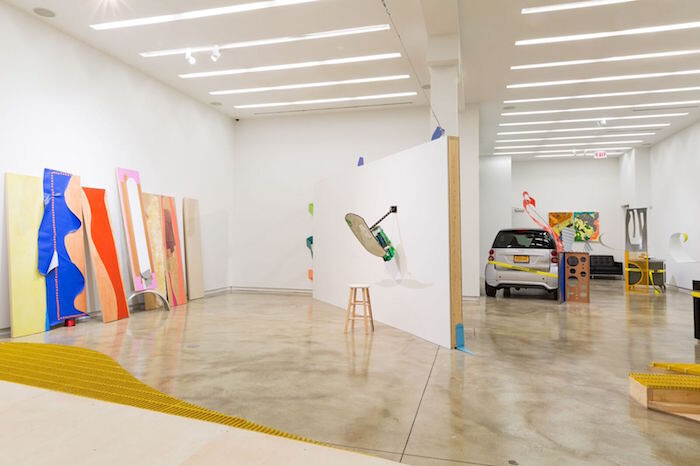
Jessica Stockholder is an artist known for breaking conventions. Though her sprawling artworks are often referred to as installations, she defines her manifold combinations of color and everyday materials as sculpture. The two floors of Kavi Gupta in Chicago—which entwine a curated group show, “ASSISTED,” with her own solo exhibition, “Door Hinges”—resemble the aftermath of a funnel cloud, with debris scrambled in uncanny composition through two stories, a testimonial to the possibility in sculpture.
Since Rosalind E. Krauss’s canonical text “Sculpture in the Expanded Field” (1979)—which referred to the rise of earthworks like Mary Miss’s Perimeters/Pavilions/Decoys (1977-78) or Robert Smithson’s Spiral Jetty (1970)—the term “field” has become an abstract metaphor for a frame or context in which an artwork exists. Stockholder posits that the term should be expanded even further; more specifically, that sculpture can be anything “around which” or “through which” the body can move. Reinforcing this development of language around contemporary sculpture, Stockholder elevates the importance of the preposition in communicating a wonder of form, as if terms like “above,” “beneath,” “beyond,” or “below” might even become materials in the construction of an artwork. Thus, building on the concept of how door hinges function, these works articulate the qualities …
January 15, 2014 – Review
John Sparagana’s “Crowds & Powder”
Daniel Tucker
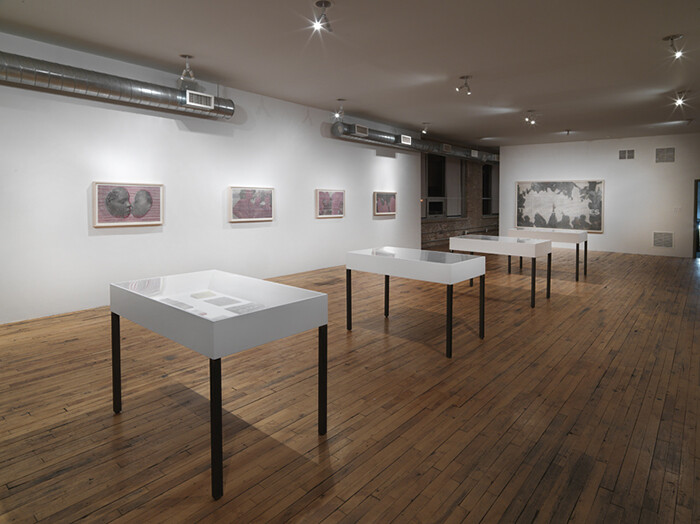
It is tempting to venerate images of bodies gathered, simply because they are seductive. They contain the charge of all that is political—the possibility of power in conflict. For this reason, they appear consistently in the mediated distribution channels and propaganda produced by the powerful and the powerless alike, ranging from cable news to social media, serving as manipulated evidence of legitimacy, potential, and control that stands in for and tells the stories of political events. The appearance of such “image-myths” preoccupies John Sparagana’s recent body of work at Corbett vs. Dempsey.
In his 1960 socio-historical tome Crowds and Power, Bulgarian-born author Elias Canetti identifies a distinction between the open and closed form of a crowd. The open crowd is characterized chiefly by its desire to grow, and when growth ceases, it dissipates. Conversely, the closed crowd “renounces growth” and by putting up boundaries, it “creates a space for itself which it will fill.”(1) While the open crowd has impressive spontaneity, the closed crowd remains stable because it is such a controlled form of gathering that the crowd knows it can reform and reassemble as needed, and often at regular intervals.
The Houston-based Sparagana utilizes images of both open and closed crowds …
June 26, 2012 – Review
Arturo Herrera’s "Series"
Michelle Grabner
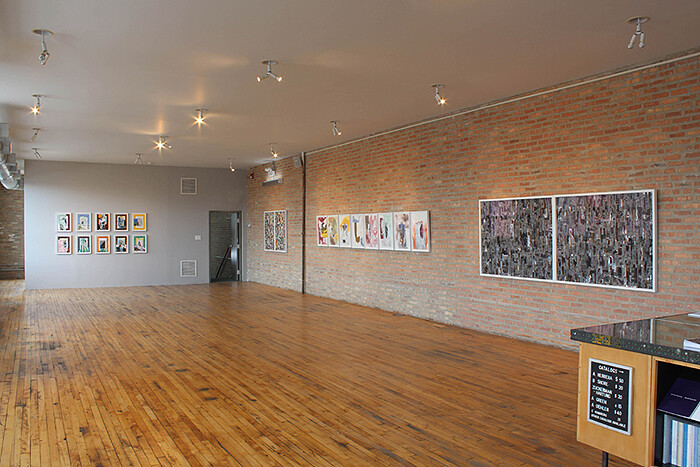
Collage is Arturo Herrera’s preferred medium. He deploys its vast paper-based vocabulary the same way an abstract painter would activate a range of color, mark, stroke, and line. But it is the juxtaposition of disparate imagery, structural invention, and the disjunction of fragments and surfaces that drive his collages. Critic George Baker writes that rather than being the medium of the “new,” as it was in the early twentieth century with the work of Picasso and Braque, that “collage was born instead of dilapidation and decrepitude, at its best with yellowed, crumbling newspaper, fading wallpaper, and discarded junk, and trash. It was a language of depletion and deletion, more destructive than constructive in its essence.” (1) That is to say, in the Modern trajectory, collage and the medium’s many political positions are not the overarching foundations to Herrera’s formally scrupulous compositions. Instead, Herrera’s collages occupy an indistinct state, bringing together fragments to create a mimetic effect, piecing together found imagery so that archetypal psychology can make claims to the cognitive processes of memory, awareness, and recognition. With pragmatic elegance from his worktable, Herrera achieves this with scissors, glue, and a nearly endless reserve of found material.
His exhibition at Corbett vs. …
November 29, 2011 – Review
Rodney Graham
Michelle Grabner
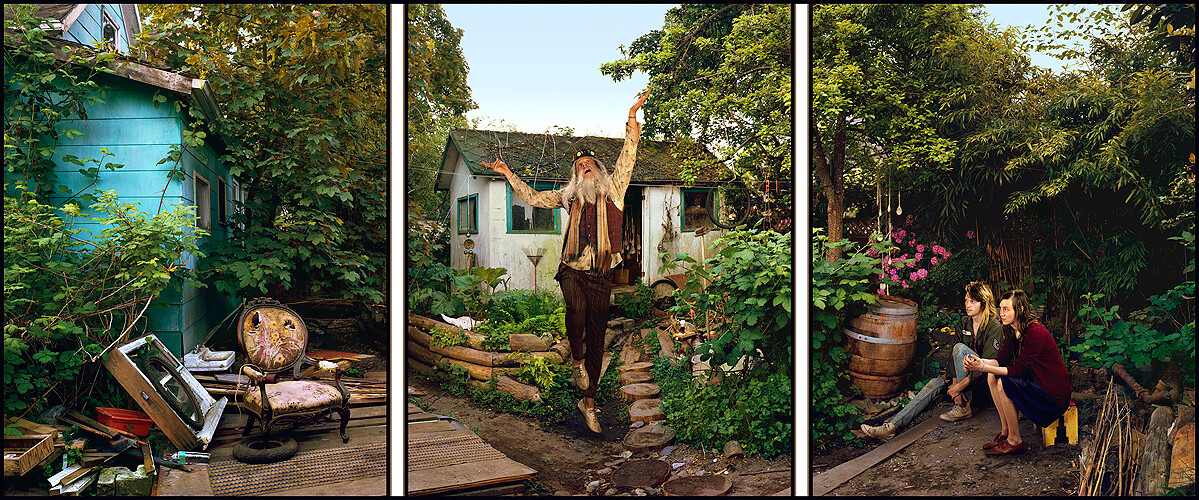
“Our culture hero is not the artist or reformer, not the saint or scientist, but the entrepreneur. (Think of Steve Jobs, our new deity.) Autonomy, adventure, imagination: entrepreneurship comprehends all this and more for us. The characteristic art form of our age may be the business plan.” This cultural postulate is a passage pulled from the article titled “Generational Sell,” recently penned by William Deresiewicz for The New York Times.[1] Its overarching thrust suggests that today’s youth culture, including the Hipsters and the Millennials, are cozy with commerce: self-producing, self-publishing, self-managed, and self-promoting their identity. “The self today is an entrepreneurial self, a self that’s packaged to be sold,” claims Deresiewicz. Enter Rodney Graham’s new body of light boxes. These painstakingly detailed and meticulously pieced together digital tableaux exhibit Graham as an actor on stage in roles, albeit, out of place and time. Culled together from a commingling of his personal memories and found photographs, Graham’s glowing illustrations are soporific character studies in step with a photographic tradition that extends from Julia Margaret Cameron’s Victorian allegories to Cindy Sherman’s film stills in the late 1970s.
Nonetheless, Graham, a worldly-wise, middle-age man, is recognizable as he dons several roles in his compositions. …
May 25, 2011 – Review
Rinus Van de Velde’s “Dear David Johnson,”
Michelle Grabner
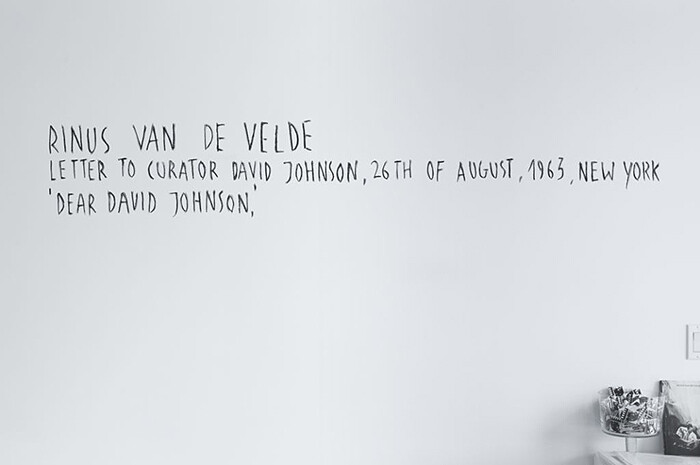
Combining realist fiction with strains of truthiness, Rinus Van de Velde harnesses our contemporary compulsion for storytelling for its own sake, stating, “although the stories I create are fictional, I still try to believe in them.” But he also employs fiction as a literary device to undercut a host of cultural clichés. Unafraid of irony, reflexivity, and the old fashioned morality tale, “Dear David Johnson,” one chapter in an ever-developing fake autobiography, examines art world perversions and other bewildering ontological issues embedded in the creation of art. Undercurrents of social networking collide with postmodern critical theory in Van de Velde’s floor-to-ceiling wall-written pages. The all-over hand-scribed text is punctuated with charcoal drawings that loosely illustrate the seven-paragraph letter of nearly a thousand words, to the fictional curator David Johnson. Engulfing the gallery, the installation of text and images creates a dramatic and dwarfing effect on the viewer, as if one has been dropped onto the parchment of an artist’s journal.
Addressed to David Johnson, the letter dated August 26th, 1963, is an apology and a defense for missing a scheduled appointment with the curator. In the grip of an existential crisis albeit an old artist-genius cliché, the author of the letter, …
April 5, 2011 – Review
Claire Sherman’s "Palms Wild"
Michelle Grabner
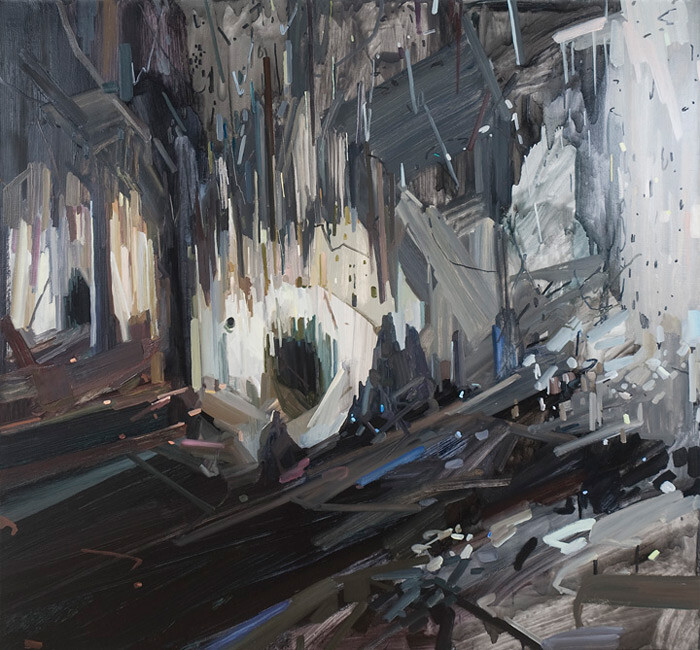
Representational landscape is a risky genre. Its natural grandeur and boundless perspectives can seduce, instilling wonder and discovery. Yet more often, the genre triggers trite familiarity with both the subject and the material quality of the medium. Claire Sherman, however, with her nimble brushwork and compositional restraint, manages to navigate the perceptual underpinnings of landscape painting while confidently delivering its abstract realities. Back in the 19th century, Albert Bierstadt, a virtuoso at conjuring the extreme picturesque dazzling landscapes of the American West, elicited profound consternation from his critics. His depictions of glimmering mountain valleys, spectrum flecked waterfalls, and incandescent sunsets were shunned for their shameless idealism and their gaudy staging of the sublime. The only similarity that Claire Sherman shares with Bierstadt is an uncommonly large canvas size and the desire to demonstrate the profound magnitude in the natural world wrought by virtue of paint. Yet where Beirstadt employed fantastic illusionist devices to convey dense atmospheric perspectives, Sherman conversely models the physical properties of paint to constitute the organic and inorganic structures of landscape.
This is not to say that Sherman’s landscapes are flat. On the contrary, they are constructed, or, moreover, built, so that geological formations and foliage sit on …
November 18, 2010 – Review
Karl Haendel’s "My Invisible Friend" at Tony Wight Gallery, Chicago
Michelle Grabner
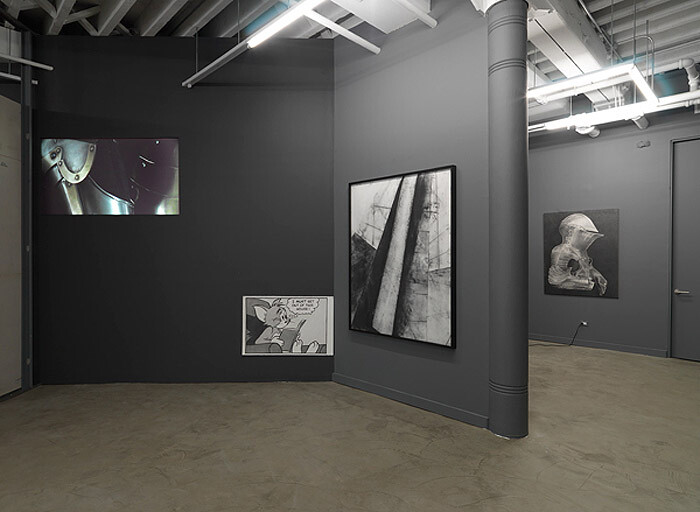
“I must get out of this house,” betrays the thought bubble floating near Tom’s bewildered expression as he sits in an overstuffed chair with an open book in his hands. Tom, the feline-half of the notorious duo Tom & Jerry, sits alone without his little tormentor in Karl Haendel’s Tom & Jerry #3 (2010), a hand-drawn graphite appropriation of a comic panel that muses on Tom’s self-awareness. The book the cat holds in this frame is a generic “everybook,” and its ability not to hold Tom’s attention undercuts the very notion of storytelling to which he exclusively belongs. In Haendel’s decontextualized comic, re-rendering Tom in a moment of contemplation emancipates him from the cultural construction of storytelling.
Haendel is an ambitious inheritor of the promiscuous appropriation strategies practiced by the Picture Generation artists of the 80s. His interest in redrawing and re-presenting images however is notably less skeptical and less ironic than that of the early work produced by Robert Longo, Troy Brauntuch, and Barbara Kruger. Yet Haendel too is compelled to detach and recontextualize the images, objects, and signs that orbit his field of interest, resulting in work dedicated to similitude and semiotics. In his project at the Tony Wight …